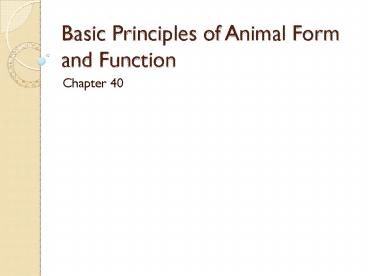Basic Principles of Animal Form and Function - PowerPoint PPT Presentation
1 / 19
Title:
Basic Principles of Animal Form and Function
Description:
Basic Principles of Animal Form and Function Chapter 40 Animal Tissues What are tissues? Groups of cells with common structure and function. Epithelial Tissues ... – PowerPoint PPT presentation
Number of Views:87
Avg rating:3.0/5.0
Title: Basic Principles of Animal Form and Function
1
Basic Principles of Animal Form and Function
- Chapter 40
2
Animal Tissues
- What are tissues?
- Groups of cells with common structure and
function. - Epithelial Tissues
- Connective Tissue
- Nervous Tissue
- Muscle Tissue
3
Organs
- Different tissues organize into organs
- Stomach has 4 tissue layers
- Epithelium lines lumen and secretes digestive
juices - Connective tissue lies outside this epithelium
- Smooth muscle lies next
- Connective tissue on outermost layer
- Mesenteries are connective tissues that hold
organs in place
4
Body Cavities
- What are the two body cavities found in mammals?
- Thoracic cavity houses the lungs and heart
- Abdominal cavity lower cavity separated by
diaphragm - Organ systems
5
Digestive Mouth, pharynx, esophagus, stomach, liver, intestines, pancreas, anus Processes Food
Circulatory Heart, blood vessels, blood Distribution of materials
Respiratory Lungs, trachea Gas exchange
Immune, Lymphatic Bone marrow, lymph, thymus spleen, white blood cells Body defense
Excretory Kidneys, ureters, bladder, urethra Removal of metabolic waste, water balance
Endocrine Pituitary, thyroid, pancreas etc Coordination of body activities
Reproductive Ovaries, testes and associated organs reproduction
Nervous Brain. Spinal cord, nerves, sensory organs Response to stimuli
Integumentary Skin, hair, claws, etc Protection against desiccation, and infection
Skeletal Skeleton, bones, tendons Body support
Muscular Skeletal muscles movement
6
Bioenergetics
- Food contains the energy that keeps animals
alive. - Metabolic rate total energy an animal uses per
unit time - Endothermic animals are warmed by metabolism,
must work to keep body temperature constant - Ectothermic animals warm themselves by absorbing
heat from their environment
7
- BMR basal metabolic rate of resting endothermic
animal - SMR standard metabolic rate of ectotherm at a
specific temperature - What causes the inverse relationship between
metabolic rate and size? - Greater SAvolume in small animals, causes
greater loss of heat
8
Body Plans
- Single celled organisms have entire surface area
in contact with environment - Simple multicellular organisms keep flat body
plan with thin cells - Larger more complex animals fold their internal
surfaces to keep exchange with environment.
9
Homeostasis
- Interstitial fluid internal fluid found between
body cells - Homeostasis maintaining a steady state
- Feedback circuits help maintain homeostasis
10
Covers outside of body and lines organs and
cavities. Notice how structure fits function.
11
Made of collagen, non-elastic does not tear easily
12
(No Transcript)
13
(No Transcript)
14
(No Transcript)
15
(No Transcript)
16
(No Transcript)
17
(No Transcript)
18
(No Transcript)
19
(No Transcript)































